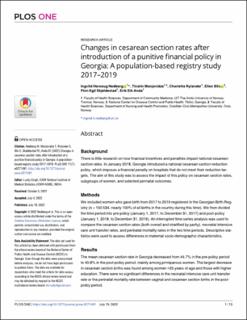| dc.description.abstract | There is little research on how financial incentives and penalties impact national cesarean section rates. In January 2018, Georgia introduced a national cesarean section reduction policy, which imposes a financial penalty on hospitals that do not meet their reduction targets. The aim of this study was to assess the impact of this policy on cesarean section rates, subgroups of women, and selected perinatal outcomes.
Methods
We included women who gave birth from 2017 to 2019 registered in the Georgian Birth Registry (n = 150 534, nearly 100% of all births in the country during this time). We then divided the time period into pre-policy (January 1, 2017, to December 31, 2017) and post-policy (January 1, 2018, to December 31, 2019). An interrupted time series analysis was used to compare the cesarean section rates (both overall and stratified by parity), neonatal intensive care unit transfer rates, and perinatal mortality rates in the two time periods. Descriptive statistics were used to assess differences in maternal socio-demographic characteristics.
Results
The mean cesarean section rate in Georgia decreased from 44.7% in the pre-policy period to 40.8% in the post-policy period, mainly among primiparous women. The largest decrease in cesarean section births was found among women <25 years of age and those with higher education. There were no significant differences in the neonatal intensive care unit transfer rate or the perinatal mortality rate between vaginal and cesarean section births in the post-policy period.
Conclusion
The cesarean section rate in Georgia decreased during the 2-year post-policy period. The reduction mainly took place among primiparous women. The policy had no impact on the neonatal intensive care unit transfer rate or the perinatal mortality rate. The impact of the national cesarean section reduction policy on other outcomes is not known. | en_US |

